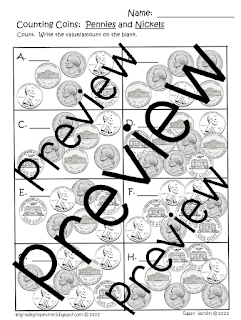This first one, is the unit I just finished teaching with my second grade math students... Money: Learning All About Coins. Teaching money can be so challenging to many students! Everything I make is a product of my own teaching. I tweak it as I go, making changes and additions to address all the needs that arise throughout the unit. Looking back, I realized I needed to have spent more time earlier in the year, teaching skip-counting, so I emphasized it in this product.
I've started it off with coin identification. I spend one week on this. I've included posters that point out all the differences of each coin. Then we move to reviewing skip-counting. You can choose which one to give your students: a hundred or a hundred-twenty board, both are included. Slides to show whole class help you guide your students through counting practice, of various coin combinations.
There are activity sheets for students to use as individual counting practice. I start by only combining two coins, pennies and nickels. Once successful with those, I move on to counting nickels and dimes, then on to quarters with a variety of other coins. I spend one week on this skill.
Now... I teach my students two organizational strategies; to write the value on each coin before they start, or they can write the running total as they count, a shown here.
In the last week of the unit, week 3, I teach my students how to solve word problems involving counting coins. I also provide a two-step set of word problems, involving making change for more of a challenge. There is a summative assessment at the end of the unit, but don't let that be your only assessment. Use the activity sheets in the second week to help you determine which kids need your extra attention in a small group setting. I actually circle the incorrect answers, and give these sheets back to my students to redo, throughout the week, while I pull a few students at a time to my small group table for extra instruction.
Here it is...
The second resource I've just uploaded to TPT is one to teach how to calculate area and perimeter, titled Area and Perimeter Task Cards
We start out learning how to measure perimeter, the distance around an object, by counting the number of squares going around the "perimeter" or border of the shape.
Then I teach them how to calculate perimeter when the squares are gone and only measurements are left. It can really through them for a loop when only two sides have measurements. Thats when we have to review what we already know about polygons... they have the same length or with on both parallel sides.
Once most have mastered perimeter, we move on to area, in the same manner. First, by counting all the squares that fill up the "area" of the shape just like an "area rug" would.
Then I teach them how to calculate the area of the shape by multiplying the length by the width.
This resource has 10 perimeter task cards and 10 area task cards, a recording sheet and an answer sheet. This is great for a math center, small group or sometimes I use it as a BUMP-style activity around the room.
I hope these resources are helpful to you! Have a great week teaching!!!


































